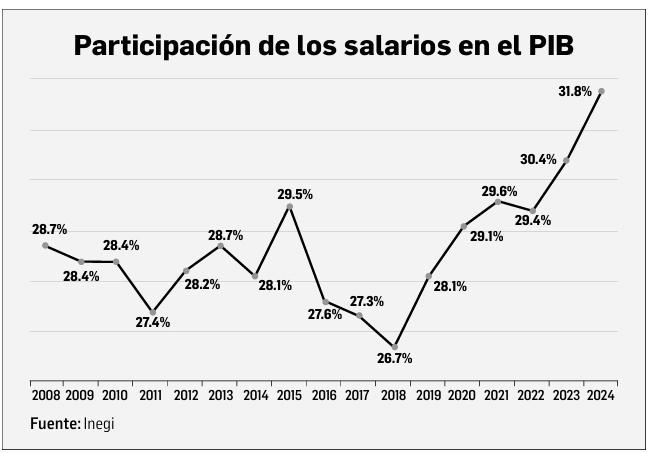MEXICO’S WAGES AS SHARE OF GDP HIGHEST IN DECADES
This article by Braulio Carbajal originally appeared in the May 30, 2025 edition of La Jornada, Mexico’s premier leftist daily newspaper.
The share of wages in Mexico’s gross domestic product (GDP), a measure of income distribution, improved steadily last year, reaching its highest point in four decades, reflecting improved worker perceptions, according to official data released yesterday.
Workers’ wages were equivalent to 31.8 percent of GDP in 2024, a substantial improvement from the 26.7 percent they represented at the end of 2018, when former President Andrés Manuel López Obrador’s administration began, reported the National Institute of Statistics and Geography (INEGI).

INEGI monitors, quarter by quarter, the proportion of workers’ wages and corporate profits in GDP. In recent decades, with the start of the economic opening and liberalization reforms initiated in the 1980s, workers’ share decreased, as the corresponding share of corporate profits increased.
Data from the National Institute of Statistics and Geography (INEGI) show that in the mid-1970s, workers’ wages accounted for 40.6 percent of the gross domestic product. This proportion dropped to 31 percent in the mid-1980s, when the country faced a profound economic crisis, so severe that the period became known as the Lost Decade.
In the mid-1990s, with another crisis looming, in which the banking system collapsed and was subsequently bailed out by the government through Fobaproa, the share of wages in the economy fell to 28 percent, while the remainder came from corporate profits, according to data from INEGI.
By 2008, the share of workers’ wages had remained constant at 28.7 percent, a proportion that by 2012 was 28.2 percent.
In 2018, when the previous administration and the wage recovery policy began, workers’ incomes accounted for 26.7 percent of GDP, according to data from the National Institute of Statistics and Geography (INEGI).
In 2024, Mexico’s GDP was equivalent to 35.3 trillion current pesos, of which corporate profits accounted for the majority, at 39.8 percent, while workers’ wages accounted for 31.8 percent, according to data from INEGI.
Wages grew by 10.8 percent, while corporate profits grew by 3.6 percent.
Data from the end of 2024 show that during the six-year term of former President Andrés Manuel López Obrador, workers’ wages gained ground compared to corporate profits. In 2018, wages represented 26.7 percent, while the latter accounted for 44.2 percent.
The wage share data shows the momentum that the minimum wage increase brought about during the previous term and that continued this year under Claudia Sheinbaum’s administration.
The minimum wage has seen significant increases from 2018 to the present. In 2019, it rose 16.2 percent; 20 percent in 2020; for 2021, the increase was 15 percent; in 2022, 22 percent; in 2024, it was 20 percent; and for 2025, it was 12 percent. During that period, it went from 88.40 pesos to 278.80 pesos [daily], an increase of 215 percent.
This coincides with the release of a report by the organization México ¿Cómo Vamos? based on data from the National Institute of Statistics and Geography (INEGI), which indicates that working poverty has fallen to 33.9 percent, its lowest level on record.
This significant reduction is primarily due to the minimum wage increase policy, labor measures, and social programs, said Luis F. Munguía, president of the National Minimum Wage Commission, in a social media post.
-
The Poor as Instruments, Not Allies
Welfare programs with political aims are not the same as forging political alliances with the impoverished population created by voracious neoliberal capitalism.
-
The Bolivarian Republic of Venezuela
The entire Venezuelan people are showing courage in defending their sovereignty, writes MORENA deputy Magdalena Rosales Cruz.
-
Was There A Regime Change After 2018?
Two narratives on Mexican politics after AMLO’s election and the historical processes that overwhelm them.




